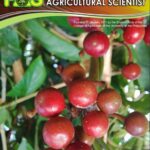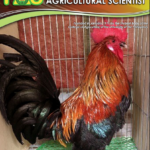Vol. 107, No. 3 (Sep 2024)
The katmon (Dillenia philippinensis) flower has five fragrant white petals which are large, showy, and about 15 cm in diameter with reddish pistils and stamens. It is solitary and terminal. Flowers in full bloom may shed their petals on the same day or after, then the fruit starts to develop.
{Photograph courtesy of Dr. Amparo M. Wagan, Agricultural Systems Institute, College of Agriculture and Food Science, University of the Philippines Los Baños.} (https://doi.org/10.62550/RI0910703)
Categories
Articles
Postharvest Characterization and Storage of Fresh Katmon Fruit (Dillenia philippinensis)
Leonisa A. Artes, Amparo M. Wagan, Michelle E. Omana, and Leonardo L. Tamisin
Received: September 5, 2023/ Revised: July 1, 2024/ Accepted: July 4, 2024
Katmon fruit has great economic potential, but little is known about its postharvest behavior. This study characterized the katmon fruit after harvest so that appropriate handling may be recommended to extend its shelf life during storage or market display. Physicochemical characteristics, particularly firmness, pH, total soluble solids (TSS), titratable acids (TA), and TSS:TA ratio were evaluated during storage under room condition (22ºC) and at low temperature (15ºC). These characteristics were almost constant under 22ºC or at 15ºC for two weeks, with pH at 2.8, TSS at about 3.40Brix, TA at 1.1% – 1.5%, and TSS:TA ratio at 3.10 – 2.04. Only moisture loss significantly increased, reachin...
Katmon fruit has great economic potential, but little is known about its postharvest behavior. This study characterized the katmon fruit after harvest so that appropriate handling may be recommended to extend its shelf life during storage or market display. Physicochemical characteristics, particularly firmness, pH, total soluble solids (TSS), titratable acids (TA), and TSS:TA ratio were evaluated during storage under room condition (22ºC) and at low temperature (15ºC). These characteristics ...
The Mutual Effects of Pinching and Promalin® on Root Architecture in Two Boxwood Species
Ömer Sari and Fisun G. Çelikel
Received: March 29, 2024/ Revised: July 20, 2024/ Accepted: August 6, 2024
Boxwoods are constantly pinched to shape and form hedges, and Promalin® application is used to boost their shoot yield. Having good root development is crucial for the healthy development of plants; however, the effects of such applications on plant root development have generally been ignored in previous studies. Hence, this study evaluated the effects of applications on the root growth of two boxwood species (Buxus sempervirens L. and Buxus balearica Lam.) during the summer dormancy period. Pinching and Promalin® (0, 1 000, 2 000, and 4 000 ppm) were applied to one-year-old seedlings at three different times. Results showed that pinching had a negative effect on root development in both...
Boxwoods are constantly pinched to shape and form hedges, and Promalin® application is used to boost their shoot yield. Having good root development is crucial for the healthy development of plants; however, the effects of such applications on plant root development have generally been ignored in previous studies. Hence, this study evaluated the effects of applications on the root growth of two boxwood species (Buxus sempervirens L. and Buxus balearica Lam.) during the summer dormancy period....
A P-graph Approach for Planning Sustainable Rice Straw Management Networks
Maria Victoria Migo-Sumagang and Michael Angelo B. Promentilla
Received: April 18, 2022/ Revised: April 4, 2024/ Accepted: June 30, 2024
The Philippines produces up to 15.2 Mt of rice straw waste annually. Unmanaged rice straw waste disposal can lead to pollution from open field burning. On the other hand, rice straw agricultural waste can be used sustainably to produce valuable products such as mushrooms, fodder, pellets, or bioenergy, in a rice straw management system. Such systems can be optimized using Process Integration tools so that the raw materials are used efficiently at the maximum profit and with a minimal carbon footprint. The P-graph framework is an efficient Process Integration tool that solves Process Network Synthesis problems. A P-graph finds the optimal and sub-optimal solutions for further analysis, whi...
The Philippines produces up to 15.2 Mt of rice straw waste annually. Unmanaged rice straw waste disposal can lead to pollution from open field burning. On the other hand, rice straw agricultural waste can be used sustainably to produce valuable products such as mushrooms, fodder, pellets, or bioenergy, in a rice straw management system. Such systems can be optimized using Process Integration tools so that the raw materials are used efficiently at the maximum profit and with a minimal carbon f...
Development of Disc Blade Cutting System for Sesame Harvesting: Determination of Operating Criteria and Energy Requirements
Selcuk Ugurluay and Gamze Genc (https://doi.org/10.62550/JP092023)
Received: October 16, 2023/ Revised: July 15, 2024/ Accepted: July 29, 2024
This study aimed to explore the use of rotary disc blades in cutting, since the mowing units used in sesame harvesting contain many parts, require frequent lubrication, and have vibration problems. An experimental setup with a disc blade working on a cut-mowing system based from harvesting methods of sesame plants was designed and fabricated. The most suitable cutting criteria which are blade edge types (30°- 30°, 30°- Flat, 45°- 45°, 45°- Flat) and disc blade diameters (150, 180, and 210 mm) were determined for shearing and disc cutting action. The lowest cutting energy was consumed by the disc blade with a 30°- wedge angle at all stem thicknesses and by the disc blade with a diameter of...
This study aimed to explore the use of rotary disc blades in cutting, since the mowing units used in sesame harvesting contain many parts, require frequent lubrication, and have vibration problems. An experimental setup with a disc blade working on a cut-mowing system based from harvesting methods of sesame plants was designed and fabricated. The most suitable cutting criteria which are blade edge types (30°- 30°, 30°- Flat, 45°- 45°, 45°- Flat) and disc blade diameters (150, 180, and 210 mm)...
Effect of Stocking Density on Growth, Biochemical Composition and Blood Parameters in the Pacific Shortfin Eel Anguilla bicolor pacifica elvers
Frolan A. Aya, John Carlo L. Unida, Luis Maria B. Garcia, and Ma. Rowena Romana-Eguia (https://doi.org/10.62550/FJ061023)
Received: June 22, 2023/ Revised: June 5, 2024/ Accepted: June 7, 2024
This study examined the effect of stocking density on growth, biochemical composition, and blood parameters of the Pacific shortfin eel Anguilla bicolor pacifica. Elvers (1.95 ± 0.14 g body weight) were randomly stocked in indoor tanks and reared over 186 d at three stocking densities (0.3, 0.6, and 0.9 kg m-3) set up in triplicates. Except for survival and biometric indices, elvers maintained at 0.3 and 0.6 kg m-3 densities exhibited higher growth and feed utilization than those held at 0.9 kg m-3. Yield increased with stocking density, which were significantly higher at 0.6 and 0.9 kg m-3. RNA/DNA ratio did not reflect growth rate, but trends in survival and RNA/DNA ratio with stocking ...
This study examined the effect of stocking density on growth, biochemical composition, and blood parameters of the Pacific shortfin eel Anguilla bicolor pacifica. Elvers (1.95 ± 0.14 g body weight) were randomly stocked in indoor tanks and reared over 186 d at three stocking densities (0.3, 0.6, and 0.9 kg m-3) set up in triplicates. Except for survival and biometric indices, elvers maintained at 0.3 and 0.6 kg m-3 densities exhibited higher growth and feed utilization than those held at 0.9 ...


